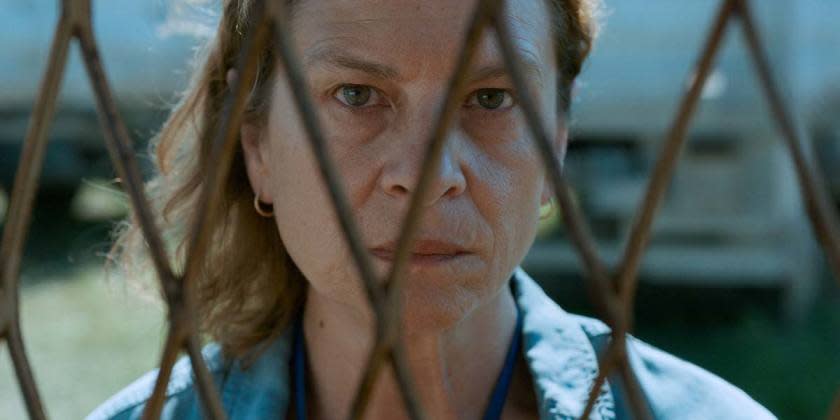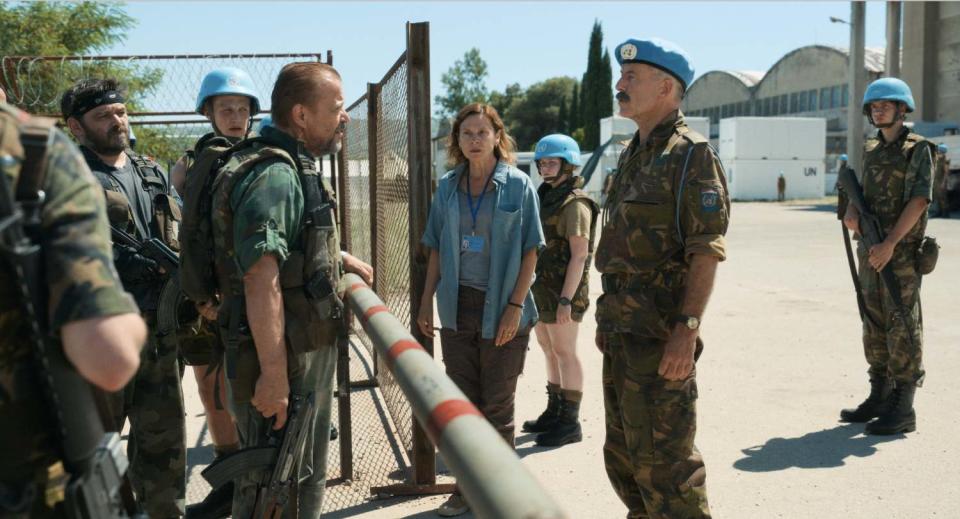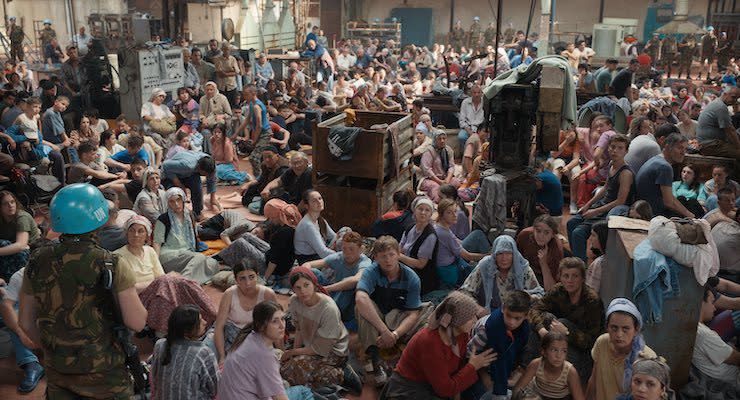Review: 'Quo Vadis, Aida?,' Bosnia and Herzegovina's Oscar entry, grippingly recounts a 1995 tragedy

In “Quo Vadis, Aida?,” Jasmila Žbanić’s swift and shattering movie about the 1995 Srebrenica massacre, a woman climbs onto a small structure and stares out over a barbed-wire fence into a sea of weary bodies and frightened faces. This is Aida (Jasna Đuričić), and she’s searching for some of her family members, but as the camera pans across the crowd, echoing her desperate gaze, the enormity of the tragedy at hand comes into focus.
It’s not the last time Aida will experience this elevated vantage, sometimes with a megaphone in hand as she translates instructions and information for her fellow refugees. She knows her words are worthless, a mix of vague reassurances and outright lies; she also knows that, under the circumstances, hearing the truth might be just as futile.
Crowd shots in wartime movies, from “Gone With the Wind” to more recent digital-extra spectaculars, run the risk of numbing the viewer, of overwhelming us with so many heartrending details that they turn mass suffering into abstraction. But the details somehow never blur in “Quo Vadis, Aida?,” which manages to hold background and foreground in unsettling balance for 102 taut, terrifying minutes.
Žbanić, who wrote and directed the film (and just earned a British Film Academy nomination for best director), doesn’t take a panoramic approach. She keeps her focus on Aida, a Srebrenica schoolteacher turned United Nations interpreter working on behalf of a town she suspects is doomed and trying to spare her family the same fate. But the bigger picture never recedes into the smaller one. As Aida races the clock, it becomes clear that her family’s survival, if it comes to pass, will be a rare and privileged exception.
The story opens in July 1995 in the eastern Bosnian town of Srebrenica, declared a demilitarized safe zone by Dutch U.N. peacekeepers. Žbanić doesn’t waste time on preamble; the war has been raging for three years, and Aida is our lone guide to the horrors that have befallen and will befall her hometown. It’s through her eyes — and her words, as she facilitates anxious talks between the town’s mayor and its designated protectors — that we learn that the badly outnumbered U.N. forces will be hard-pressed to keep the Serbian army from overrunning Srebrenica.

Soon thousands of civilians have retreated to the nearby U.N. base, where some manage to take refuge inside while others are left standing behind that barbed-wire fence, waiting and begging to be let in before the Serbs arrive. Aida, for her part, darts around inside and outside and back again, translating on behalf of wounded patients one minute and pleading with U.N. officials the next, desperate to ensure the safety of her husband, Nihad (Izudin Bajrović), and their sons, Hamdija (Boris Ler) and Sejo (Dino Bajrović). From time to time the tension breaks, mainly during a long night of waiting, as Aida tenderly swaps stories with a guard and also speaks to her family, with insistent optimism, about happier days to come.
But these are rare respites amid the tumult. Aida’s moral imperative, her need to do as much as she can in an impossible situation, finds powerful expression in her relentless forward momentum and the corresponding speed and agility of Žbanić’s filmmaking. Đuričić, in a performance of extraordinary physical and emotional endurance, emphasizes Aida’s sharp reflexes, her fierce intelligence and equally fierce maternal instinct. She’s initially reassured that the Serbian troops wouldn’t dare penetrate U.N. barriers, but we see the heightened urgency in her step and the mounting terror in her eyes as these and other illusions begin to crumble.
Christine A. Maier’s camera hurtles alongside her as she navigates this ostensible safe house, using her official badge to cut corners and cross boundaries. The title’s invocation of the Latin phrase “quo vadis?” (“Where are you going?”) — a reference to the apostle Peter’s flight from crucifixion in Rome — here feels like a moral inquiry, both sympathetic and reproachful, directed at Aida’s conscience. Her concern for her family above all else is an entirely human reaction, to be expected from anyone in her shoes. But even as it acknowledges this, the movie, sharply edited by Jaroslaw Kaminski, keeps feeding us sidelong glimpses of those for whom Aida can do nothing. We see a woman she knows begging for help as she runs past; people squatting to relieve themselves in the corner; hungry hands grasping at loaves of bread and boxes of Toblerones being passed out by Serbian troops.
Those troops are under the command of the notorious general Ratko Mladić (Boris Isakovi´c), first shown striding through the abandoned streets of Srebrenica before later calling for a sham negotiation with town representatives. (Nihad, a school principal, is named one of those representatives, as part of Aida’s increasingly desperate tactics to save him.) The movie is, among other things, a coolly excoriating assessment of the U.N.’s failure to intervene and keep the Serbian army at bay — a failure born not just of insufficient firepower, but also of geopolitical pressures hovering beyond the scope of the frame. The extent of their capitulation becomes clear once Mladić’s troops, working at the direction of Joka (a terrifying Emir Hadžihafizbegović), begin separating civilians by gender and herding them onto buses.

You’ve seen images like these in other movies drawn from real-life atrocities, a grim cinematic canon to which Žbanić, who spent the Bosnian war years under siege in Sarajevo, has been steadily contributing. Two of her earlier features, “Grbavica: The Land of My Dreams” (2006) and “For Those Who Can Tell No Tales” (2013), were set in the years after the war, excavating brutal memories and bringing untold horrors to light. But “Quo Vadis, Aida?” re-creates history in the present tense, with a gut-clutching immediacy that Žbanić makes bearable through sheer formal restraint: This is a movie about the murders of more than 8,000 Bosnian Muslims, mostly boys and men, in which graphic violence is never shown and yet the worst is never remotely in doubt. The withholding of that violence doesn’t feel like equivocation; it feels like an attempt to move beyond the bludgeoning conventions of cinematic realism, to acknowledge the unspeakable without relying on a spectacle of blood.
“Quo Vadis, Aida?” first screened last fall at the Venice International Film Festival alongside Andrei Konchalovsky’s “Dear Comrades!,” which was inspired by a very different tragedy — the 1962 shootings of protesters in Novocherkassk, Russia — but whose act of cinematic remembrance bears some pointed resemblance to Žbanić’s own. (Both films, which are available for streaming, have been shortlisted for the Oscar for best international feature.) Each movie is about a woman whose job grants her access to the truth and whose determined intervention on her family’s behalf winds up stripping away layers of official deception and doublespeak. Like so many war crimes throughout history, the Srebrenica massacre has been denied, downplayed and even defiantly rationalized in some quarters, even as the arrests and convictions of its engineers (including Mladić) and the discoveries of mass graves have told a different story.
Žbanić’s movie traces that story to its horrific conclusion and beyond, jumping years ahead to a wintry coda that feels by turns damning, haunting and faintly consoling. Aida is no longer running; she’s not at peace, but she is at least at rest. The ghosts of the past still flicker into view in the faces of an old acquaintance and a new generation of children, most of them unaware of the secrets buried in the ground they call home. But Aida knows and cannot forget them, any more than she herself can be forgotten.
This story originally appeared in Los Angeles Times.

